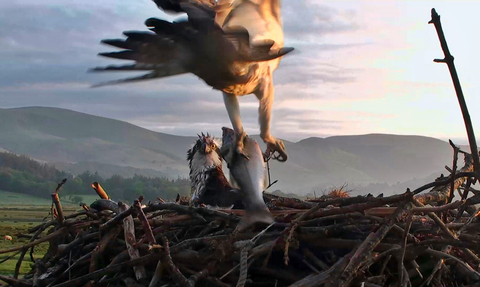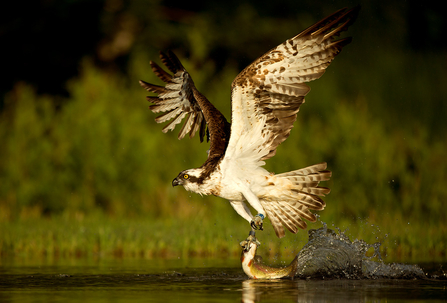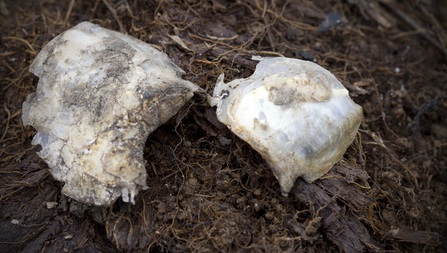
© MWT
Osprey Diet and Fishing
Ospreys eat fish and nothing else; they are piscivores!
Over millions of years, they have acquired specialised evolutionary adaptations to be completely reliant on catching, transporting, eating and digesting fish.
Perhaps the most enduring part of an osprey's ecology that makes them so interesting is their diet. Ospreys and humans have fished the same lakes, rivers and estuaries for tens of thousands of years around the world. Over evolutionary time, we have quite literally grown up with them.
Fishing Methods
Ospreys have two main ways of catching fish.
1. The wet method: Soaring or hovering above the water's surface from between 10 - 30m, the osprey will dive head and talon first into the water at great speed after identifying a suitable fish prey. After plunging up to a metre under the water, the osprey will surface, position its wings above the waterline and with great strength, become airborne from a half submerged, stationary position.
2. The dry method: Rather than hunting from altitude, an osprey will fly almost parallel to the waterline and pluck any surface feeding fish straight out of the water getting only its legs wet. This method is usually used in warmer countries where the fish live near the water's surface.

An osprey catches a fish - the dry way! by kind permission © Andy Rouse
Here are a few things we have learnt over the years from watching ospreys fishing and eating their catch.
Size of Fish
Ospreys will catch anything from tiny minnows weighing only a few grams to fish of almost their own weight - up to 2Kg or 4½ pounds. Most however, are around a pound in weight or less. Females can catch larger fish and therefore different species of fish, as they are, on average, 10 - 15% larger than male ospreys.
MWT Glesni catches a whale (https://youtu.be/4uh7xaFWp3A)
Here's Glesni with a whale of a mullet - probably approaching the same weight as her...
Types of Fish
Ospreys live on all continents on earth except Antarctica, they have a huge variation of fish species they catch. The old English name for osprey is 'Mullet Hawk' which gives us a pretty good idea what their main fish prey species in the UK (and actually, where they nested) was before they were persecuted to extinction by 1916.
Every year, we record what species and size of fish the Dyfi ospreys catch. Roughly speaking, around half are grey mullet, 20% are flounder and 20% are trout. The other 10% consist of other fish like sea bass, garfish and perch.
Nora, the breeding female at the Dyfi in 2011 and 2012, had a great dislike of flounders (or to be more scientific - had a least preference for flounders). There may be a good reason for this. Of all the fish caught by Monty, flounders not only have the highest water content and the least calories, but they are also very tough and take more calories to eat. Think of all those neck muscles straining to tear bits off. This is very hard to prove scientifically but is based on our (anecdotal) observations. Its a bit like the celery story - it takes more calories to eat celery and to digest it than there are in it! (the actual facts are of course, not correct - it's a myth).

Nora feeding her two chicks in 2012: Please Monty, no more flounders...
In 2011, Monty caught a 'Twaite Shad' - an extremely rare fish in UK waters belonging to the Herring family. So rare in fact, you need a license to catch one. Monty, we are reliable informed, now has all the relevant paperwork in plaice(!) During the last few years, ospreys breeding in Scotland have started to catch mackerel where historically they had not. This could either be as a consequence of more ospreys choosing nest sites nearer the sea, or a change in the feeding behaviour of the ospreys. Or both!
Bits Ospreys Don't Eat
Every year at the Dyfi we check carefully the areas underneath the osprey nest and various perches. We find loads of 'opercula'. The operculum is a hard flap covering and protecting the gills of a fish, it's made out of fused bones. They look a bit like your Granddad's big toe nail! This is the only part of the fish that the osprey can't eat.

Two operculums, plural opercula!
Fishing Success
Ospreys won't catch a fish at every attempt. Young fledglings have a very poor success rate, around 5% to start with. However, as they acquire more experience, this success rate shoots up considerably. A 2010 study of ospreys fishing on an estuary in the northern Iberian Peninsula showed an average success rate of 69%. Young birds caught fish around two times in every five attempts (40%) whilst more experienced adults caught a fish nine times out of ten attempts (92%).